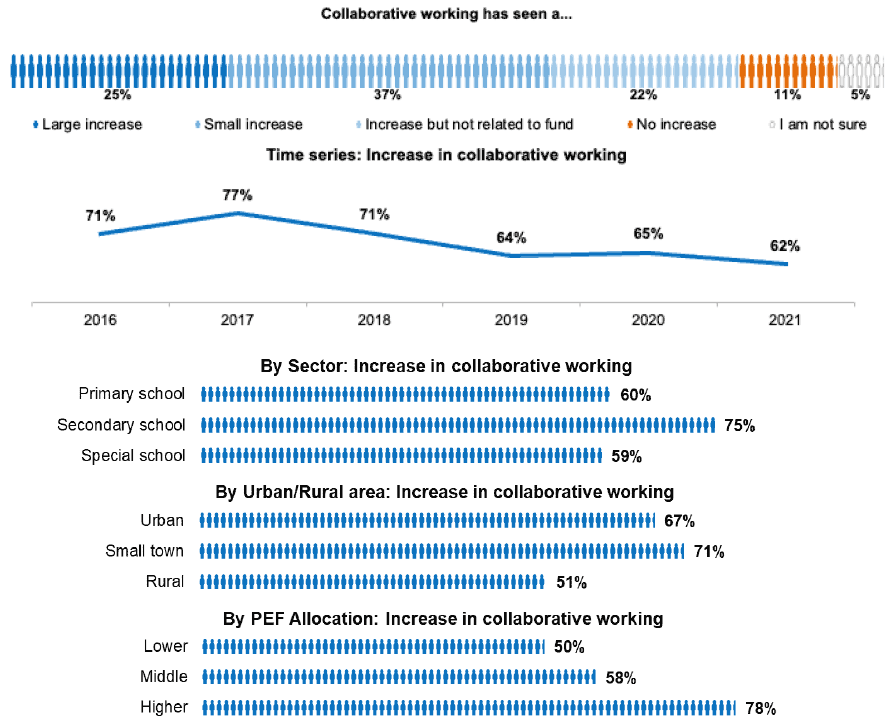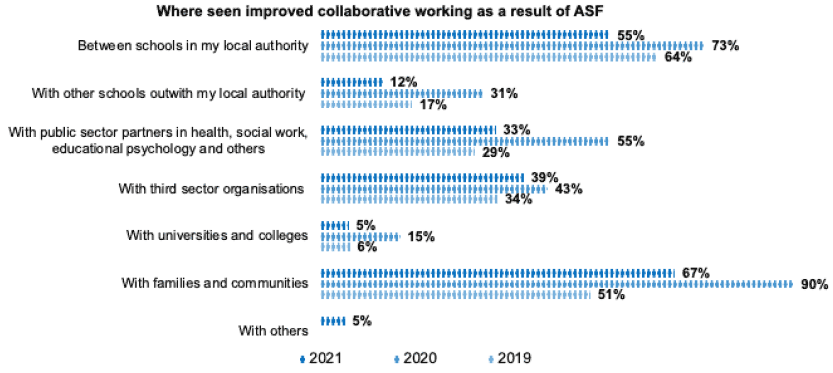Attainment Scotland Fund evaluation - Headteacher Survey: 2021 report
This report presents key findings from the sixth survey of headteachers of schools in receipt of Attainment Scotland Fund (ASF) support, covering the 2020 to 2021 academic year including the period of school building closures from January to March 2021.
5. Collaborative working
5.1. This section summarises views on whether and how ASF support has contributed to an increase in collaborative working.
5.2. The majority of survey respondents had seen an increase in collaborative working in their school as a result of ASF support. Nearly two thirds (62%) indicated this, including a quarter (25%) who had seen a large increase in collaborative working as a result of the fund. This was broadly consistent with 2020 survey findings, although the proportion reporting increased collaboration has fallen consistently since the 2017 survey (by 15-percentage points over this period).
5.3. Survey findings show some variation in school experiences around collaborative working. In particular, those with lower PEF allocations, those in rural areas and primary schools were less likely to have seen an increase in collaborative working.

5.4. In terms of types of collaborative working, schools were most likely to have seen an increase in collaboration with families and communities (reported by 67% of schools), and other schools in their local authority (55%). A substantial proportion of schools also mentioned increased collaboration with third sector organisations (39%) and public sector partners (33%).
5.5. Survey findings show fewer schools reporting increased collaboration with families and communities (down by 23-points since 2020 - although as Figure 14 shows, a large majority of schools indicated that engagement with families and communities remained part of their approach to equity), public sector partners (-22 points), and other schools in their local authority (-18 points).
5.6. There was some variation across respondent groups, particularly for collaboration with third sector organisations. Challenge Authority schools, secondary schools, those in urban areas and those with higher PEF allocations were most likely to have increased collaborative working with third sector organisations.

5.7. Headteachers were asked to provide comment outlining any new collaborations that have emerged during the period of school building closures. The main points raised by respondents are summarised at Table 12.
| With third sector organisations and community groups | 60% |
|---|---|
| With public sector organisations, particularly health and social care, mental health services | 31% |
| With other schools, primarily local cluster | 13% |
| With families and communities | 7% |
| With private sector organisations | 4% |
5.8. Work with third sector organisations and community groups was the most commonly referenced new collaboration for schools, mentioned by more than half. This included national charities such as Barnardo’s and Action for Children, local voluntary organisations including a particular focus on those supporting families affected by poverty, and local faith groups.
5.9. Around a third of those providing comment referred to new or improved collaboration with public sector organisations. This included schools working with NHS services, local authority services (including social work, Community Learning & Development, housing and financial inclusion), and Police Scotland.
Contact
Email: socialresearch@gov.scot
There is a problem
Thanks for your feedback